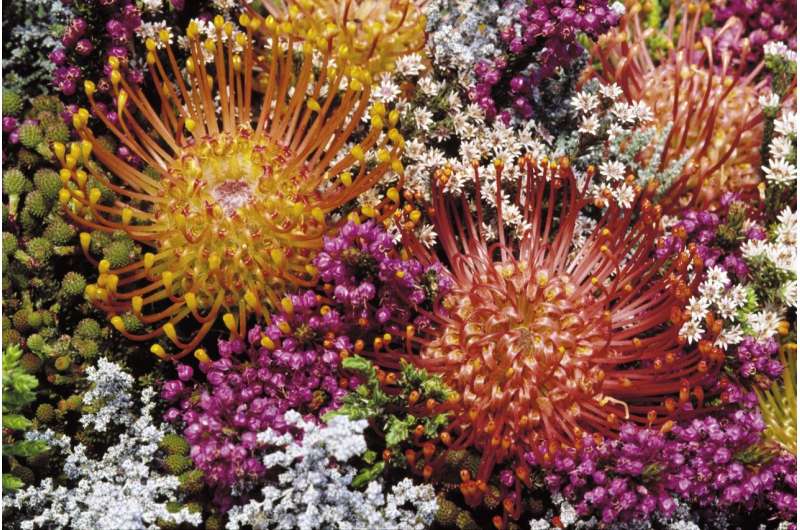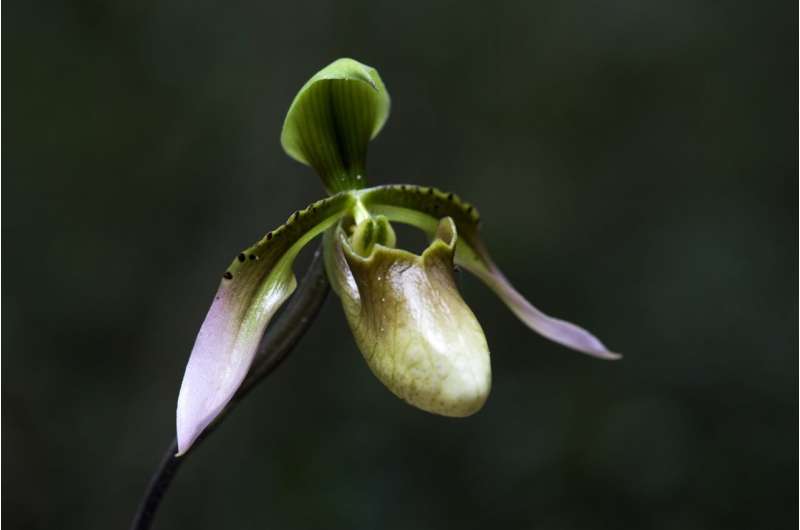A fynbos bouquet from South Africa. Credit: Juan Pablo Moreiras/Fauna & Flora
Everybody loves a garden.
Stately homes with acres of azaleas. Campanula-crammed cottage gardens. Balconies bursting with blooms outside a fourteenth-floor flat. They all bring joy to their owners and to visitors.
Exotic houseplants—from the ubiquitous Swiss cheese plant to blazing bromeliads, ostentatious orchids and flowering cacti—are a welcome addition to any room, and a vase of fresh flowers can lift our spirits on the dullest of days.
But do you ever ask yourself where all these plants come from? The local garden center or superstore isn't the answer we're looking for here.
Take your flower bulbs, for instance.
Where do flower bulbs come from?
We have news for you. Tulips are not from Amsterdam. Most wild tulips hail from the mountainous regions of Central Asia. Kyrgyzstan, Tajikistan, Kazakhstan and Uzbekistan—countries not widely recognized as havens of biodiversity—harbor the lion's share of species.
Turkey is also one of the richest areas in the world for bulbs, including familiar garden favorites such as snowdrops, crocuses, cyclamens and, yes, tulips too.
It's easy to forget that these wild relatives are the original source of the endless varieties and hybrid forms that grace our gardens and fill our flower vases. And that they face a variety of threats, from overharvesting and habitat loss to climate change.
Where do houseplants come from?
Obviously, there is no single answer to this question. But the important thing is to ask it. Swiss cheese plants, for example, are native to South America. In the wild state, they are epiphytes. This means that—unlike money—they do grow on trees, clinging onto crevices in the bark with their exposed roots.
With one notable exception, bromeliads are found only in Central and South America. A single species—endangered and known only from Guinea—occurs in West Africa. Most bromeliads are also epiphytes, but the one that we're most familiar with—though you may not think of it as a bromeliad—grows on the ground and produces one of our most popular tropical fruits, the pineapple.
Have you ever wondered where your cactus came from? We've all seen those iconic images of baking deserts peppered with prickly pears and other charismatic cacti, but don't be fooled by the Westerns you've watched. Cacti may be famous for their tolerance of extreme heat and drought—and plummeting temperatures at night—but they're not confined to hotspots like the American Midwest and Mexico.
There are roughly 2,500 species of cactus in the world, and quite a few of them thrive in rainforests or cooler climes. The Christmas cactus that flowered in your bathroom last December is native to damp forest in the coastal mountains of Brazil.
This exquisite slipper orchid was discovered during a survey in Cambodia’s Cardamom Mountains. Credit: Jeremy Holden/Fauna & Flora
Where do orchids originate?
Orchids occur naturally in the wild in most parts of the world. They occupy almost every habitat you could imagine, stretching from north of the Arctic Circle and down through tropical forests to southern Patagonia. Comprising a staggering 28,000 species—that's double the number of bird species and four times the number of mammals—orchids are one of the two biggest families of flowering plants.
They have been around for many millions of years, but it's thought they were first cultivated in China and Japan several thousand years ago. Orchids have huge symbolic and cultural value. Many are the chosen national flowers of the countries where they originate.
Orchids, especially the species collectively known as "slipper" orchids due to the distinctive shape of their flowers, hold an almost mystical fascination for amateur gardeners and serious collectors alike. Due to their popularity, many species have been driven to the brink of extinction by illegal collection and trade.
Should I buy wild orchids?
If you're wondering whether to buy wild orchids, please think again. All orchids are protected by CITES (the Convention on International Trade in Endangered Species of Wild Fauna and Flora) and, for the rarest species, all commercial international trade in wild-sourced specimens is prohibited.
Most cultivated orchids are descended from tropical or subtropical species, but temperate varieties such as bee orchids—whose flowers mimic female bees, inducing male bees to pick up pollen while trying to "mate" with them—are also sold in nurseries.
Where do supermarket flowers come from?
Cut flower sales in the U.K. are worth nearly £900m per year, and most of these are imported. Almost three-quarters of these come from the Netherlands, but a small percentage are flown in from further afield—and distance traveled doesn't always mean higher emissions.
The more responsible growers will ensure that their flowers are sustainably harvested and that the lives of the workforce are improved. Certification, for example through the Fairtrade label, is usually a reliable guide.
You may never have heard of fynbos—the catch-all term for a unique vegetation type in South Africa's Cape Floral Kingdom—but the chances are that you have bought a bouquet of flowers that came from this botanically rich biome.
Why is fynbos so special?
Put simply, this habitat harbors more species of native plant, relative to its size, than even the richest tropical rainforest. This includes every one of the world's 350+ known protea species—almost half of which are threatened with extinction—as well as myriad familiar flowers such as heathers, irises, freesias, lobelias, gerbera daisies and orchids. An astounding 5,800 of these plants are found nowhere else on Earth.
Fauna & Flora has worked closely with a local partner in South Africa to support sustainable harvesting of these spectacular blooms. Ethically sourced fynbos bouquets sold in the U.K. and South Africa generate vital income that is plowed back into the local economy, improving the lives of impoverished local communities.
How do I ensure that my plants are sustainably sourced?
Sustainable gardening is just as important to the planet as sustainable fishing. The environmental damage wrought by over-harvesting of plants, illegal trade, habitat destruction, energy-guzzling giant glasshouses and our insistence on using peat cannot be overstated.
By taking a few simple steps, you can ensure you're part of the solution not part of the problem. Propagate plants from cuttings. When you do buy a bouquet, bulbs or houseplants, check the label, stick to products certified as sustainable, ethical and carbon neutral. Ask awkward questions. Favor local growers and seasonal blooms. Avoid novelty plants that are designed to die. Boycott peat products. Choose sellers who use biodegradable—or, better still, zero—packaging.
Provided by Fauna & Flora International

























